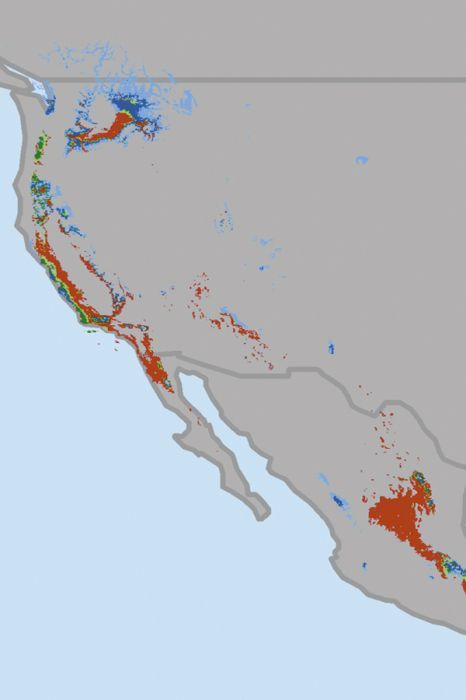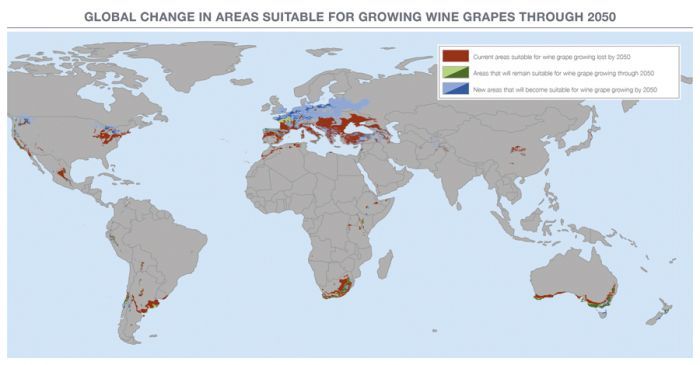Ch-Ch-Ch-Changes


By Karl Klooster
I’ve never considered myself as an alarmist. But the preponderance of evidence from some of the most noted scientists around the world can no longer be ignored or denied.
Hitting home for the wine industry, the first study to analyze impacts of climate change on wine production was recently published in the Proceedings of the National Academy of Sciences. The key finding of a group led by Conservation International is that “climate change will dramatically impact many of the most famous wine-producing regions in the world today. It will create new areas suitable to wine production in unusual places, which would likely degrade or put pressure on the critical natural ecosystems that support species and human well-being.”
The current areas suitable for wine grapegrowing will shrink by more than 70 percent in certain parts of the world by mid-century. Sounds far in the future, doesn’t it? Yet, 2050 is only 37 years away. I doubt if I’ll be around then, but the odds are good that two-thirds of Americans now alive will be.
The learned men and women who did the research that created this report don’t want to spread panic or cry gloom and doom. But, by giving advance warning, they are making it possible for us to plan ahead. That is, if we heed their words and begin to take action now.
Another study, this one of “American attitudes,” indicates the number of Americans who believe global warming really is happening has declined. Today, just over 60 percent of adults think it’s genuine and even many of them don’t think it’s a really serious problem. It won’t be that bad, we’ll adjust, and what can we do about it anyway? A peculiar and perhaps fatally flawed human trait is to avoid admitting reality when it comes to seemingly overwhelming problems, much less try to do anything about them.
It’s true. Mother Nature is one mighty tough mama. You can’t call her bluff, and if you try to go at her head-on, you’ll likely lose. But you can outsmart her.
Determining suitable grapegrowing regions farther north or south, or at higher elevations, is key. Some of those potential places may lie within protected or precarious ecosystems, but there will be lots of other places just as good. And by starting now, the sooner they will come to light. Organizations such as Conservation International have the capability to do just that. All they need is broader support from a concerned and caring public putting pressure on the politicians.
“The world is our laboratory,” a spokesperson for the Washington, D.C. based nonprofit said. “It’s where we conduct research and find solutions. Our scientists are in the field every day, monitoring environmental threats and taking action where it’s needed most — and where it will do the most good.
“Science is the cornerstone of everything we do. It helps pinpoint places with critical natural capital, so we can identify where every dollar spent will have the maximum impact.
“Using cutting-edge capabilities, we assess today’s most critical environmental challenges, from the economics of healthy sustainable societies to site-based monitoring of biodiversity and ecosystem services.”
Obviously, the consequences of global warming reach everywhere in the world of agriculture, not simply wine. But it is interesting that winegrapes are a bellwether crop. As the study emphasized, “Winegrapes are particularly sensitive to climate. Findings are symbolic for what will happen with other agricultural commodities.”
And it’s none too soon to act. Adaptation strategies to minimize the impact on terrestrial and freshwater ecosystems are needed now.
As for winegrapes, dry farming is widely practiced in Oregon, which means no watering. However, if, as is being predicted, average temperatures continue to rise and rainfall declines, there will be no choice — water or die. Addressing that issue, Dr. Lee Hannah, the study’s co-author and senior scientist for climate change biology at the Moore Center for Ecosystem Science and Economics, said, “Consumer awareness, industry and conservation actions are all needed to help keep high quality wine flowing without unintended consequences for nature.”
Maki Ikegami, with the Bren School of the University of California at Santa Barbara, said, “Vineyards are already expanding into the predicted suitable areas rapidly. Conservation measures in those areas must be taken immediately.”
The dilemma is obvious. How can a small winery owner adjust, with all his or her capital tied up in planted land, buildings and equipment? Tending one vineyard while also starting up another one many miles away as the climate slowly changes sounds like far too much to successfully undertake.
If you’re like me, you do believe that climate change is coming. It will be relentless and unstoppable. Sooner, or later, everyone who grows winegrapes and makes wine from them will have to change along with it.
Perhaps that formidable task will fall to another generation of wine industry professionals. But if the current one starts taking steps now to moderate the intensity of that transition, everyone will be the beneficiaries.












